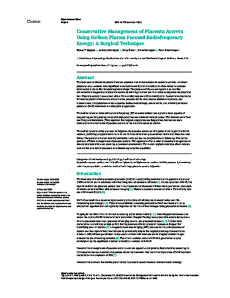Conservative Management of Placenta Accreta Using Helium Plasma Focused Radiofrequency Energy
ITEM TYPE:
Journal Article
AUTHORS:
Bianca T. Nguyen, Anthony Rodriguez, Naiya Patel, Diana Rodriguez, Peter Khamvongsa
ABSTRACT:
The incidence of abnormal placentation has escalated due to the increase in cesarean sections. Adherent placentas are associated with significant maternal morbidity and mortality and often result in cesarean hysterectomy due to life-threatening hemorrhage. The purpose of these case reports is to describe conservative management of placenta accreta by utilizing a helium plasma device to fulgurate the placental bed. Placenta accreta is associated with a 7% mortality rate and 60% morbidity rate. Conservative treatment for uterine preservation include embolization, placenta left in-situ, uterine balloon tamponade, and methotrexate. Complications of these options include hemorrhage, endometritis, and morbidly adherent placentas (MAP) recurrence in subsequent pregnancies.
The helium plasma device utilizes radiofrequency (RF) to ionize helium into a plasma beam capable of coagulating and fulgurating tissue with high precision and minimal thermal spread. This instrument is Food and Drug Administration (FDA) approved for surgical coagulation and fulguration, but has not been evaluated in the treatment of placenta accreta at the time of a cesarean section.
The helium plasma device was used to fulgurate the placenta accreta at 40% power 4 L/min gas flow for 30 seconds, providing adequate hemostasis to the 12.76 cc of retained placental bed. Estimated blood loss was 560 cc. The patient remained hemodynamically stable and had no complications at follow up. The device provided efficient management of placenta accreta. This approach offers a safer alternative management of abnormal placentation and avoiding a cesarean hysterectomy. This novel surgical technique allows women with morbidly adherent placentas to maintain reproductive capability.
APYX® MEDICAL DISCLOSURES:
FINANCIAL & CONTENT DISCLOSURE
This literature was not supported by Apyx Medical, Inc. The author has no financial connection with Apyx Medical, Inc. other than as a purchaser. The opinions contained herein are those of the authors(s) and do not necessarily represent the official position or policies of Apyx Medical, Inc.
MANUFACTURING DISCLOSURE
Apyx Medical manufactures and owns the Renuvion®/J-Plasma® technology discussed in this article.
INDICATIONS FOR USE & INTENDED USE DISCLOSURES
- The Renuvion Precise, Precise Open, and J-Plasma Handpieces are intended to be used with compatible electrosurgical generators for the delivery of radiofrequency energy and/or helium plasma for cutting, coagulation, and ablation of soft tissue during open surgical procedures.
- Apyx Medical wants to present to you with current scientific discourse.
RISKS
- Risk associated with the use of the device may include: Helium embolism into the surgical site due to inadvertent introduction into the venous or arterial blood supply system, unintended burns (deep or superficial), pneumothorax, temporary or permanent nerve injury, ischemia, fibrosis, infection, pain, discomfort, gas buildup resulting in temporary and transient crepitus or pain, bleeding, hematoma, seroma, subcutaneous induration, pigmentation changes, increased healing time, and/or unsatisfactory scarring. There may be additional risks associated with the use of other devices along with Renuvion/J-Plasma and there may be an increased risk for patients who have undergone prior surgical or aesthetic procedures in the treatment area.
As with any procedure, individual results may vary. As with all energy devices there are inherent risks associated with its use, refer to the IFU for further information.



